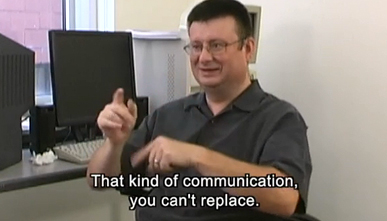Collaboration project between people with disabilities and the media
In 2008, DREDF launched the Disability and Media Alliance Project (D-MAP). The goal of the program is to shift the focus from sensationalist, saccharine, and misinformed disability reporting that undermines the progress in public policy and law of the past 25 years to reporting that raises public awareness and helps eliminate disability discrimination.
D-MAP will establish mechanisms to monitor and provide information on disability reporting in news reports, dramatizations and internet coverage, with the aim of promoting accurate reporting on disability issues and fostering positive images of people with disabilities.
Images and stories

Healthcare Story by Nick Ziemer
Media images and stories influence thinking and establish social norms. People with disabilities have endured misrepresentation, vilification, and lack of representation in media news and entertainment. While the disability rights movement has made great strides over the past 30 years through legal and policy developments and civil rights advocacy, our movement has not yet changed the hearts and minds of people who do not have personal experience of disability. Many people still do not understand disability issues as rights issues.
Fears and stereotypes about disability are deeply ingrained in our culture and reflected in media coverage. As a result, people with disabilities are rarely seen as individuals beyond their disability. A history of stigmatizing, isolating and institutionalizing people with disabilities has left us with negative and inaccurate beliefs and attitudes about what it means to live with a disability. These attitudes are accepted and reflected in media coverage, many of which rely on old stereotypes and misinformation.
More in-depth and thoughtful consideration of disability is needed. The media is a powerful force against prejudice and misinformation and can be a powerful ally in changing perceptions, eliminating discrimination and raising public awareness.
Video Advocacy
Video advocacy uses new imaging technologies to create documentary campaigns for social and political change through visual evidence, personal stories, and precise audience targeting. Video advocacy has had a profound impact on organizational advocacy and grassroots activism in many sectors, making it an effective new tool in the nonprofit social justice community. As communications media change, there has been an explosion of digital technology, including the widespread use of video storytelling, to support a culture of participation and sharing. Healthcare Stories leverages this important tool.
resource
Technology Accessibility
Web Accessibility
Litigation
DREDF also has a number of resources on a variety of topics, from creating accessible web content to accessible design principles.
like this:
Like Loading…

